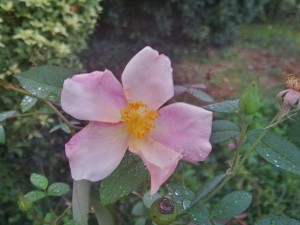
When I am alone in my garden in late October I often think about music, especially Ralph Vaughn Williams’ elegiac settings of English folk tunes. My favorite is the haunting “Fantasia on Greensleeves,” because the musical images just seem right for the season of variable weather, early sunsets and mornings when the grass glistens with frost. “Greensleeves” is about memories, and on the surface the garden is on its way to becoming a repository of memories. Rose hips on the once-blooming bushes remind me of their fragrant summer blossoms, and the ever-increasing piles of brilliant fallen maple leaves take me back to the spring days when the newborn leaves were the size of mouse ears. The roses of Sharon’s abundant seed pods make me think fondly about the clouds of hollyhock-like late summer flowers.
But as I go about the business of planting the usual excessive number of bulbs, raking away the leaves and clipping spent aster stalks, I am struck by the vibrancy that still looms all around me. So many plants have vigor left. The columbine leaves, for example, are as fresh and green as they were in May–maybe more so. The scented geraniums, awaiting return to the indoors, are huge. The rosettes on the first-year foxgloves are also enormous, oblivious to the fact that they won’t produce flower spikes until next spring. Roses that have been deadheaded recently still pop occasional blooms and some have produced new reddish leaves. ‘Ghislaine de Feligonde’, an old-fashioned shrub rose, has been so busy sprouting new canes that she has not even paused to acknowledge the cooler temperatures. Butterfly bushes that I pruned a month ago do not look as if they are about to descend into winter gloom. Tiny larkspur seedlings are coming up all over the back garden, and in the lower garden, the brunnera or false forget-me-nots, are plump and apple green. Even Sarah, the fifteen year-old charcoal-gray cat, interrupts her daily naps to languish on the front porch, lying in a square of sun and watching the world go by. She goes no farther than the porch, but she shows no inclination to come inside, lest winter creep in while she is not paying attention.
So I rake carefully to keep from disturbing those tiny larkspurs. I continue to weed. I stifle the urge to defy the seasonal imperative and divide the overgrown ‘Autumn Joy’ sedum. When I see a blossom on any plant, I leave it there or clip it for an indoor bouquet. I don’t worry about the new growth on the roses because I have a sense that the roses know what they are doing.
Of course much of this growth and greenness will end when the hard frosts come in the next few weeks. The still-blooming dahlias will turn black in the cold and the exuberant morning glories will die. The gradually cooling soil will turn even colder. Right now, though, it is a joy to be outside because there is so much life under every dead leaf.
I used to think that the best way to get through late fall in the garden was to focus on great expectations and dream about spring. After all, those bulbs sleeping under the soil are like debutantes, indulging in a long bout of beauty rest before the big horticultural coming-out party next April and May. Since the party was already arranged, it was easy to dismiss the end of October and the onset of November as a collection of depressing days with little to look at except blackened flower stalks and large leaf piles. But now I know better, and my greatest pleasure comes from watching the abundant life and changing scene every day in my beds and borders. Waiting and hoping are good and necessary, but celebrating the here-and-now is even more important, especially as we turn back the clocks and get adjusted to the fact that winter looms
